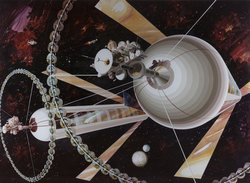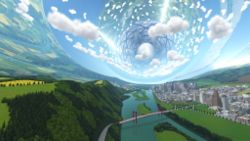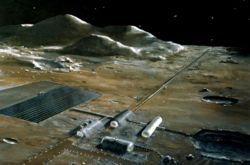Difference between revisions of "Space habitats"
(→Surface of Mars) |
|||
| Line 20: | Line 20: | ||
==Life support== | ==Life support== | ||
| + | There have been several attempts on Earth to construct a {{wp|Closed_ecological_system|closed ecological system}} and we have learned a lot from these. If we can build a fully closed ecological system on Earth, there is no reason why we cannot do so in space. | ||
| + | |||
[http://plantsrescue.com/category/chrysalidocarpus-lutescens/ Areca palm], {{wp|Sansevieria_trifasciata|Snake plant}} and {{wp|Epipremnum_aureum|money plant}} are exceptional for their ability to create clean, fresh air for people <sup>[http://www.ted.com/talks/kamal_meattle_on_how_to_grow_your_own_fresh_air.html]</sup>. A human can survive in a sealed environment with just four plants like these. The application of this to space habitats is obvious. | [http://plantsrescue.com/category/chrysalidocarpus-lutescens/ Areca palm], {{wp|Sansevieria_trifasciata|Snake plant}} and {{wp|Epipremnum_aureum|money plant}} are exceptional for their ability to create clean, fresh air for people <sup>[http://www.ted.com/talks/kamal_meattle_on_how_to_grow_your_own_fresh_air.html]</sup>. A human can survive in a sealed environment with just four plants like these. The application of this to space habitats is obvious. | ||
| Line 27: | Line 29: | ||
===Low Earth orbit=== | ===Low Earth orbit=== | ||
| − | The easiest place to get to from Earth is '''low earth orbit''', although due to the Earth's strong gravitational pull it requires enormous amounts of energy to bring material up from the surface and one could not be classed as self-sufficient here, however the views are pretty good. | + | The easiest place to get to from Earth is '''low earth orbit''', although due to the Earth's strong gravitational pull it requires enormous amounts of energy to bring material up from the surface and one could not be classed as self-sufficient here, however the views are pretty good. If we develop more efficient means of [[Colonising Space/Access to space|access to space]] than we currently have, low Earth orbit habitats become more feasible. |
===Geosynchronous orbit=== | ===Geosynchronous orbit=== | ||
| Line 36: | Line 38: | ||
===Surface of the moon=== | ===Surface of the moon=== | ||
| − | The '''surface of the moon''' provides a continent-sized area to inhabit and somewhere to 'get outside'. However it is not clear that the one-sixth of Earth's gravity here is enough to stop degredation of the human body over extended periods, but this could be overcome by having large circular habitats that rotate to simulate a | + | The '''surface of the moon''' provides a continent-sized area to inhabit and somewhere to 'get outside'. However it is not clear that the one-sixth of Earth's gravity here is enough to stop degredation of the human body over extended periods, but this could be overcome by having large circular habitats that rotate to simulate a 1g environment. |
| + | |||
| + | ===Surface of Mars=== | ||
| + | Terraforming refers to re-engineering the environment of a planet to make it more like Earth, that is, more friendly to life. To terraform Mars we need three things: heat, oxygen and water. Ironically, the very scientific knowledge gained by studying the destruction of the Earth's biosphere can be applied to engineering a new biosphere on Mars; releasing enough CFCs or similar greenhouse gases into the atmosphere should create enough global warming to make the planet amenable to human life. There is [http://antwrp.gsfc.nasa.gov/apod/ap040904.html plenty of water] frozen below the surface, which should melt if the temperature is raised enough. Oxygen could be supplied by culturing bacteria that can release it from metallic oxides, or by using [[advanced automation]] to build large-scale plants to release the oxygen using industrial processes. | ||
| + | |||
| + | After enough time in zero-gravity environments, astronauts suffer degeneration of the muscular and skeletal systems. All of Man's experience so far has either been at zero-gravity or Earth's gravity; whether Mars' low gravity will pose the same problems remains to be seen. If this turns out to be an insurmountable issue then homes and other living spaces could be built within very large diameter rotating structures on the surface to simulate 'Earth gravity'. | ||
| + | |||
| + | * [http://www.users.globalnet.co.uk/~mfogg/paper1.htm Further info on terraforming by Martyn Fogg] (an appropriate name for someone who is an expert in terraforming...) | ||
| + | |||
| + | ===Mars orbit=== | ||
| + | |||
| + | ===Mars moons=== | ||
===Lagrangian points=== | ===Lagrangian points=== | ||
| + | Possible candidate for building a space station like a {{wp|Stanford_torus|Stanford torus}}. | ||
===Near Earth asteroids=== | ===Near Earth asteroids=== | ||
| Line 56: | Line 70: | ||
===Venus surface=== | ===Venus surface=== | ||
*http://www.terraformers.org.au/start.html | *http://www.terraformers.org.au/start.html | ||
| − | |||
| − | |||
| − | |||
| − | |||
| − | |||
| − | |||
| − | |||
| − | |||
| − | |||
| − | |||
| − | |||
| − | |||
===Asteroid Belt=== | ===Asteroid Belt=== | ||
| Line 74: | Line 76: | ||
===Other moons=== | ===Other moons=== | ||
| − | Many to choose from. Enceladus around Saturn. Europa around Jupiter. | + | Many to choose from. |
| + | |||
| + | Enceladus around Saturn has H<sub>2</sub>O. | ||
| + | |||
| + | Europa around Jupiter has lots of H<sub>2</sub>O and O<sub>2</sub>. Underneath the ice are liquid oceans which may harbour life. | ||
== Various types of habitat == | == Various types of habitat == | ||
| Line 80: | Line 86: | ||
*O'Neill cylinder | *O'Neill cylinder | ||
*Crater bubble | *Crater bubble | ||
| − | *Rotating moonbase for | + | *Rotating moonbase for 1g |
*Hollowed out asteroid | *Hollowed out asteroid | ||
*Zero-G station | *Zero-G station | ||
Revision as of 01:00, 30 June 2010
|







